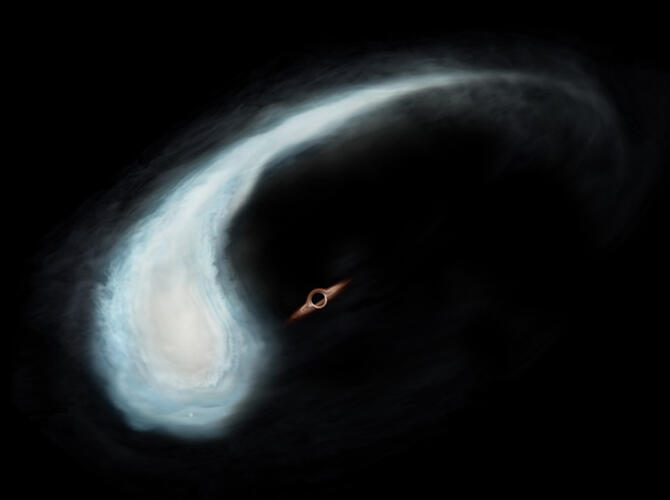Supermassive black holes at the centers of most galaxies are thought to have grown out of the merging of smaller black holes. However, no intermediate‐mass (100‐100,000 times more massive than the Sun) black holes have been found. A research team consisting of second‐year master's student Miyuki Kaneko and Professor Tomoharu Oka at Keio University's Graduate School of Science and Technology, the National Astronomical Observatory of Japan and Kanagawa University has discovered an isolated tadpole molecular cloud in the vicinity of the galactic nucleus, Sagittarius A* (A‐Star). This molecular cloud has an arc‐like shape in the celestial plane, with a radial velocity that changes monotonically along the arc, suggesting its gravitational source may be an intermediate‐mass black hole. The group's research was published in The Astrophysical Journal.

Provided by Keio University
Sagittarius A*, the nucleus of the galaxy, is thought to be a supermassive black hole with a mass four million times that of the Sun. Star cluster IRS13E is in its vicinity and has been suggested to contain an intermediate‐mass black hole, but some scientists reject this notion, so its true nature has remained a mystery.
Based on the existence of compact and unusually velocity‐broadening molecular clouds discovered in the Galactic Central Molecular Zone about six years ago, the research group has pointed to the possibility of the existence of several intermediate‐mass black holes in this region, in addition to IRS13E.
In their study, they examined carbon monoxide (CO) rotational spectral line survey data acquired using the James Clerk Maxwell Telescope to intensively search for compact, broad‐velocity‐width molecular clouds that may have been produced by the interaction with point gravity sources. In it, a 'tadpole'‐like molecular cloud was found 20 light years away, northwest of Sagittarius A*, clearly isolated from the surrounding molecular cloud cluster. Its presence was also confirmed in CO and CS (carbon sulphide) survey data acquired at the Nobeyama Radio Observatory of the National Astronomical Observatory of Japan.
A detailed analysis showed that the molecular clouds have an arc‐like shape in the celestial plane, along which the radial velocity continuously changes. This motion can be explained by considering it as orbiting a point source of gravity with a huge mass. The behavior of the physical state, which was derived from information on multiple molecular spectral line intensities, also indicated that the gas was trapped in a point‐like gravity source.
In order to find the identity of this point‐like gravitational source, the researchers checked images at various wavelengths in the sky, including 'tadpole' molecular clouds, but found no bright objects in the assumed positions, which strongly suggested that it could be an intermediate‐mass black hole.
The research team plans to use the ALMA (Atacama Large Millimeter/submillimeter Array) for high‐resolution observations, which could provide a clear view of the molecular gas.
"The velocity structure of this molecular cloud can be reproduced by a Kepler orbit around a 100,000 solar mass point‐like gravitational source, and the absence of a bright counterpart suggests that this source is most likely an intermediate‐mass black hole," explained Oka. "Many similar molecular clouds have been found in the central region of the Milky Way, where numerous intermediate‐mass black holes may be concentrated. We want to learn more about their origins."
Journal Information
Publication: The Astrophysical Journal
Title: Discovery of the Tadpole Molecular Cloud near the Galactic Nucleus
DOI: 10.3847/1538‐4357/aca66a
This article has been translated by JST with permission from The Science News Ltd. (https://sci-news.co.jp/). Unauthorized reproduction of the article and photographs is prohibited.




